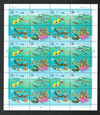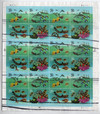
# 2863-66 - 1994 29c Wonders of the Sea
U.S. #2863-66
1994 29¢ Wonders of the Sea
Block of 4
- First US First Day ceremony to be held underwater
- Issued to kick of National Stamp Collecting Month
Stamp Category: Commemorative
Set: Wonders of the Sea
Value: 29¢, rate for first-class mail
First Day of Issue: October 3, 1994
First Day City: Honolulu, Hawaii
Quantity Issued: 225,900,000
Printed by: Barton Press for Banknote Corporation of America
Printing Method: Lithographed
Format: Panes of 24 in offset plates of 216
Perforations: 11.1 x 11
Microprinting: The year “1994” was microprinted on each stamp. It can be found on the divers’ oxygen tanks on three of the stamps and on the black and white striped fish on the fourth stamp.
Why the stamps were issued: These stamps were issued on the first Monday of National Stamp Collecting Month (NSCM). The 1994 slogan for NSCM was “Get in the swim of things – collect stamps!” This slogan was incorporated into cancellations across the country.
About the stamp design: First-time stamp artist Charles Lynn Bragg was hired to provide the artwork for these stamps after art director Carl Herrman saw his paintings hanging in a store. Herrman and Bragg were both divers and were very enthusiastic about the project. They decided that not only should the scene in each block of four blend seamlessly, but the entire pane of 24 stamps should as well. This was easy to achieve horizontally, as the sky, water surface, and underwater areas extended into the perforations. Vertically, Bragg made the bottom of the lower stamps fade into the same light color of the sky in the top stamps.
At the Postal Service’s request, four underwater themes were shown: recreation, scientific research, exploration, and commercial fishing. The first stamp depicts the sea's many recreational possibilities. Scientific research is the theme of the second stamp. The third stamp shows the marvels and joys of marine exploration, while the fourth symbolizes the benefits to mankind from commercial fishing. Bragg kept the diving equipment generic, so it wouldn’t appear to advertise any specific company. And he was given creative license to depict any sea life he wanted, so as to create a fun and colorful scene. A USPS researcher noted that many of the sea creatures came from different oceans and were out of proportion with each other. The USPS wasn’t deterred, and called the set a “fanta-sea” of stamps.
Special design details: The sea life and other elements included in each stamp are as follows:
Upper-left (#2863) – diver, outboard motorboat, black long-nosed butterfly fish, porcupine fish, frigate bird, and dolphin.
Upper-right (#2864) – diver, dolphin, booby (bird), bannerfish, and triple-masted schooner.
Lower-left (#2865) – diver, wheel of sunken ship, raccoon butterflyfish, nautilus, and star fish.
Lower-right (#2866) – diver, spot-tailed butterfly fish, striped scat, raccoon butterflyfish, clown anemone fish, and convict sturgeonfish (also known as tang).
About the printing process: Issued in panes of 24, each pane consisted of an exact number of full blocks. This was the first time this happened with a se-tenant block of four since the 1984 Orchids stamps.
First Day City: The first day ceremony for the stamps took place off Hawaii’s Waikiki Beach, 80 feet below the surface of the Pacific Ocean in a submarine. Held at a shipwrecked site, the ceremony marked the first time a US stamp was canceled underwater. Tourists taking the Atlantis Submarines tour of the area can see an enlargement of the stamps, encased in protective material, mounted on the side of the wrecked ship.
Unusual facts about this stamp: After the stamp was released, it was discovered that the artist painted the diver-down flag on the top-left stamp upside-down. The white stripe on the flag should go downward from the pole.
There have also been at least two error panes of these stamps found without perforations (#2866b).
About National Stamp Collecting Month: National Stamp Collecting Month was introduced in October 1991 to encourage “employees and customers alike to discover the joy of stamp collecting – the hobby of a lifetime.” Click here to discover more about National Stamp Collecting Month and find other stamps issued for it over the years.
History the stamp represents: Underwater diving has been practiced since ancient times. Records show that as early as 4500 BC the Greeks and Romans dove in the Mediterranean seeking pearls, shells, and sponges. It wasn’t until the 1800s that devices were built enabling people to breathe underwater. These diving bells were open to the water on the bottom and received air from the surface through a hose on top; air pressure inside the bell kept the water out.
In 1943 the aqualung was developed by French diver Jacques Cousteau and Emile Gagnan, a French engineer. The first truly safe and simple independent breathing device, their invention greatly expanded the newly emerging sport of scuba (self-contained underwater breathing apparatus) diving. Today improved equipment and techniques allow many activities to be performed underwater.
With enclosed diving vehicles, work can be performed at great depths, allowing divers to repair ships, recover valuable objects, and conduct research. In the 1960s experimental saturation habitats were developed. These manned stations consist of one or two buildings erected on the ocean floor. Divers can live there for several weeks at a time, eliminating the need for them to undergo decompression every day.
U.S. #2863-66
1994 29¢ Wonders of the Sea
Block of 4
- First US First Day ceremony to be held underwater
- Issued to kick of National Stamp Collecting Month
Stamp Category: Commemorative
Set: Wonders of the Sea
Value: 29¢, rate for first-class mail
First Day of Issue: October 3, 1994
First Day City: Honolulu, Hawaii
Quantity Issued: 225,900,000
Printed by: Barton Press for Banknote Corporation of America
Printing Method: Lithographed
Format: Panes of 24 in offset plates of 216
Perforations: 11.1 x 11
Microprinting: The year “1994” was microprinted on each stamp. It can be found on the divers’ oxygen tanks on three of the stamps and on the black and white striped fish on the fourth stamp.
Why the stamps were issued: These stamps were issued on the first Monday of National Stamp Collecting Month (NSCM). The 1994 slogan for NSCM was “Get in the swim of things – collect stamps!” This slogan was incorporated into cancellations across the country.
About the stamp design: First-time stamp artist Charles Lynn Bragg was hired to provide the artwork for these stamps after art director Carl Herrman saw his paintings hanging in a store. Herrman and Bragg were both divers and were very enthusiastic about the project. They decided that not only should the scene in each block of four blend seamlessly, but the entire pane of 24 stamps should as well. This was easy to achieve horizontally, as the sky, water surface, and underwater areas extended into the perforations. Vertically, Bragg made the bottom of the lower stamps fade into the same light color of the sky in the top stamps.
At the Postal Service’s request, four underwater themes were shown: recreation, scientific research, exploration, and commercial fishing. The first stamp depicts the sea's many recreational possibilities. Scientific research is the theme of the second stamp. The third stamp shows the marvels and joys of marine exploration, while the fourth symbolizes the benefits to mankind from commercial fishing. Bragg kept the diving equipment generic, so it wouldn’t appear to advertise any specific company. And he was given creative license to depict any sea life he wanted, so as to create a fun and colorful scene. A USPS researcher noted that many of the sea creatures came from different oceans and were out of proportion with each other. The USPS wasn’t deterred, and called the set a “fanta-sea” of stamps.
Special design details: The sea life and other elements included in each stamp are as follows:
Upper-left (#2863) – diver, outboard motorboat, black long-nosed butterfly fish, porcupine fish, frigate bird, and dolphin.
Upper-right (#2864) – diver, dolphin, booby (bird), bannerfish, and triple-masted schooner.
Lower-left (#2865) – diver, wheel of sunken ship, raccoon butterflyfish, nautilus, and star fish.
Lower-right (#2866) – diver, spot-tailed butterfly fish, striped scat, raccoon butterflyfish, clown anemone fish, and convict sturgeonfish (also known as tang).
About the printing process: Issued in panes of 24, each pane consisted of an exact number of full blocks. This was the first time this happened with a se-tenant block of four since the 1984 Orchids stamps.
First Day City: The first day ceremony for the stamps took place off Hawaii’s Waikiki Beach, 80 feet below the surface of the Pacific Ocean in a submarine. Held at a shipwrecked site, the ceremony marked the first time a US stamp was canceled underwater. Tourists taking the Atlantis Submarines tour of the area can see an enlargement of the stamps, encased in protective material, mounted on the side of the wrecked ship.
Unusual facts about this stamp: After the stamp was released, it was discovered that the artist painted the diver-down flag on the top-left stamp upside-down. The white stripe on the flag should go downward from the pole.
There have also been at least two error panes of these stamps found without perforations (#2866b).
About National Stamp Collecting Month: National Stamp Collecting Month was introduced in October 1991 to encourage “employees and customers alike to discover the joy of stamp collecting – the hobby of a lifetime.” Click here to discover more about National Stamp Collecting Month and find other stamps issued for it over the years.
History the stamp represents: Underwater diving has been practiced since ancient times. Records show that as early as 4500 BC the Greeks and Romans dove in the Mediterranean seeking pearls, shells, and sponges. It wasn’t until the 1800s that devices were built enabling people to breathe underwater. These diving bells were open to the water on the bottom and received air from the surface through a hose on top; air pressure inside the bell kept the water out.
In 1943 the aqualung was developed by French diver Jacques Cousteau and Emile Gagnan, a French engineer. The first truly safe and simple independent breathing device, their invention greatly expanded the newly emerging sport of scuba (self-contained underwater breathing apparatus) diving. Today improved equipment and techniques allow many activities to be performed underwater.
With enclosed diving vehicles, work can be performed at great depths, allowing divers to repair ships, recover valuable objects, and conduct research. In the 1960s experimental saturation habitats were developed. These manned stations consist of one or two buildings erected on the ocean floor. Divers can live there for several weeks at a time, eliminating the need for them to undergo decompression every day.
















